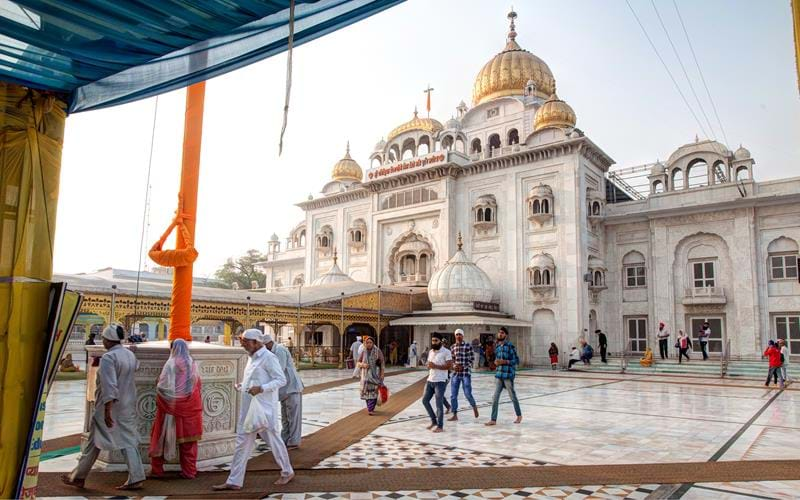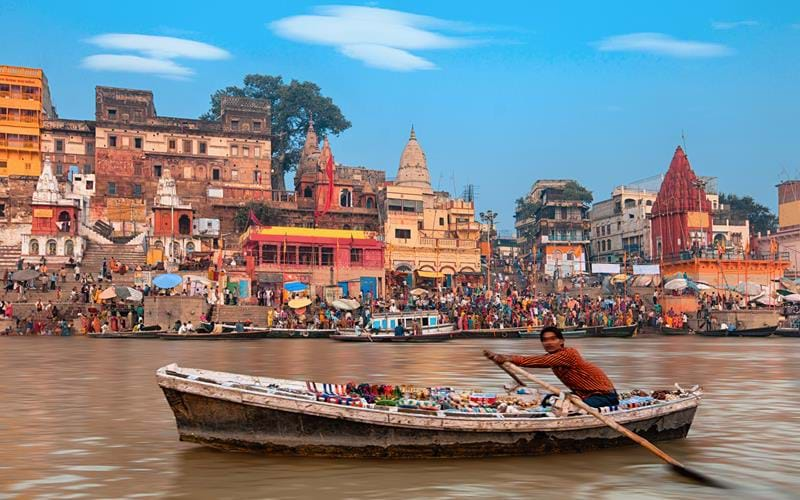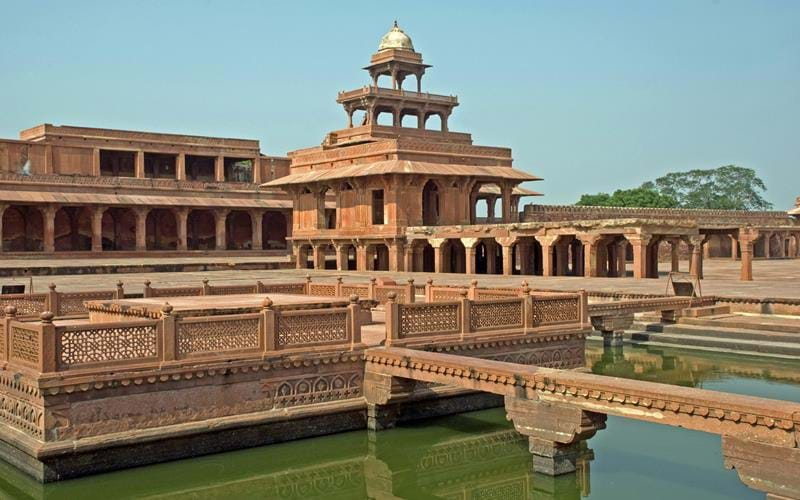One of the questions we’re most frequently asked by clients contemplating their first trip to India is ‘whether to go north or south’? This two-week…
View more
Experience India’s sacred and religious heritage on our tour of the north’s historic highlights. Spanning 2,500 years of monumental architecture, this route across the Gangetic Plains to southern Rajasthan weaves between India’s most iconic temples, palaces and forts, culminating with a stay in the dreamy lakeside city of Udaipur. In the course of a highly varied fortnight you’ll travel in the footsteps of the Buddha, experience the erotic intensity of Khajuraho’s Tantric stone carvings and watch sunrise over the Ganges at Varanasi, as well as seeing the Taj and many other fabulous medieval wonders, including a couple of rarely visited gems.
Cultural Holidays Wildlife Holidays River Cruising Holidays Luxury Train Holidays Family Holidays Honeymoons Beach Holidays Adventure Holidays
Fly overnight from the UK to Delhi.
On arrival in Delhi, transfer to the domestic airport for your connecting flight to Amritsar. You’ll be met by your TransIndus guide and driver at Amritsar airport, and escorted to your hotel, where you’ll be staying for two nights.
For pure, ethereal beauty, there’s only one building in India to rival the Taj Mahal. The Sikhs’ holiest shrine, the ‘Golden Temple’, in the Punjabi city of Amritsar, casts an undeniably powerful spell. The combined effect of the lustrous, gilded domes, the shimmering reflections in the water and hymns emanating from the shrine are at once humbling and elevating - as befits one of the world’s greatest living places of worship.
A guide would be an unnecessary distraction on your first visit. Just merge with the streams of bare-footed pilgrims strolling around the white marble terrace that surrounds the temple. Then follow the walkway to the sacred causeway of the golden Har Mandir itself, where the Adi Granth, the Sikhs’ holy book, is enshrined. Musician-priests keep a continuous soundtrack of kirtans, devotional songs accompanied by table and harmonium.
Another experience not to miss while in Amritsar are the free, communal meals served in the Guru-ka-Langa, next to the Golden Temple. Sharing food with all-comers, regardless of creed or status, is one of the central tenets of the Sikh faith, and there’s no more emphatic reaffirmation of the belief than this huge canteen, where every day thousands are served simple dal and chapattis, seated at long mats on the floor.
Visit the Golden Temple this morning. Spend the afternoon exploring Amritsar further on a walking tour or witnessing the Wagah Border ceremony.
Sunrise is definitely the best time to visit the Sikh’s holiest shrine. At first light, its resplendent golden surfaces seem to glow like molten metal, lending a transcendental atmosphere to the sacred precinct. Your guide will lead you down the steps beneath the entrance archway, from where you’ll follow the pilgrims strolling along the marble terrace that surrounds the main shrine, the Har Mandir, where the Adi Granth, the Sikhs’ holy book, is kept. All the while, musician-priests play beautiful devotional hymns accompanied by tabla and harmonium.
In every Indian city, the most interesting things to see are often the ones you’re least likely to come across under your own steam, and Amritsar is no exception. Opt for our tour of the bazaar district and you will be led to some fabulous rooftop viewpoints overlooking the Golden Temple, a banyan tree whose branches grow through multiple households, and a fascinating array of markets devoted to everything from brass pots to papadams. Best of all, you’ll get to taste the definitive Amritsari ‘lassi’, milky yoghurt flavoured with a heavenly blend of cardamom and saffron.
Another option is to head to the famous border crossing point west of Amritsar, the venue for a daily ritual in which representatives of the opposing armies open and close the gates dividing their two countries, dressed in flamboyant uniforms. As they strut and goosestep back and forth, the soldiers are cheered on by their respective crowds: something of a holiday atmosphere prevails, and despite the serious geopolitical undercurrents the event is great fun and good natured.
Fly to Delhi where you’ll be met by your driver and TransIndus guide and escorted to your hotel. Spend the rest of the day relaxing, perhaps venturing out towards early evening to visit the Gurudwara Bangla Sahib, near Connaught Circus.
Made of white marble and crowned by a gilded onion dome, the Gurudwara Bangla Sahib and shimmering pool inside it are places of great sanctity for Indian Sikhs, and offer the most atmospheric introduction possible to capital. The complex in its present form dates from the late 18th century and was constructed at a place associated with the eighth Sikh Guru, Guru Har Krishnan, who resided in a bungalow on the spot. At a Langar, or ‘canteen’ in the temple, pilgrims are fed nourishing, free meals of chapatis and black dal by volunteers. If you’re lucky, you may see groups of Akalis, members of a Sikh warrior sect, dressed in traditional ceremonial garb.
Full-day’s sightseeing, starting with a cycle-rickshaw ride through the lanes of Old Delhi, followed by a visit to the Jama Masjid mosque. In the afternoon, visit the Akshardham temple and Dargah of Sufi saint, Khwaja Nizamuddin.
Cycle-rickshaws are a relaxing, and eco-friendly, way to explore the lanes of Old Delhi. Different streets are to be given over to different trades in this atmospheric district, which formed the hub of the Mughal city. Dominating its skyline is the massive white dome of the Jama Masjid mosque, the next stop on your tour. After admiring the view from its minarets, enjoy lunch at one of the famous kebab restaurants below, before driving across the Yamuna River for a taste of modern Hinduism in the form of the vast Akshardham Mandir, officially the world’s largest Hindu temple. Afterwards, visit the ancient Sufi shrine at Nizamuddin, guided by young residents of the local neighbourhood. Clients of a project designed to alleviate poverty in the area, your young guides will enthusiastically show you around the calligraphy shops and perfumeries, and maybe invite you back to their home for tea!
Today you fly across the Ganges Plains to Varanasi, the most revered Hindu pilgrimage location in the country.
On the banks of the Ganges, Varanasi (‘Kashi’ or ‘Benares’ as it’s also known) is among the oldest continuously inhabited places on earth. Streams of Hindu worshippers still come here today to bathe in the sacred waters of the river, believed to wash away the sins of past lifetimes. After exploring the ghats and temples with your guide, you’ll return to Dashashwamedh Ghat to watch Ganga Aarti, in which teams of young priests in splendid ceremonial dress wave blazing oil lamps next to the Ganges. Devotional hymns, chants, drumming, bell ringing and gongs combine to create an intense atmosphere.
Take a boat trip on the Ganges in the morning, then join a walking tour of the old city with a specialist local guide. In the afternoon, visit the Buddhist pilgrimage site of Sarnath.
South Varanasi has always been considered the city’s more serene, contemplative flank. For centuries, poets, philosophers and musicians have tended to congregate in the neighbourhood, whose ancient cultural legacy you can experience on this fascinating walking tour.
Sarnath was where the Buddha gave his first sermon in 530BC, revealing the ‘Eight-Fold Path’ to his five disciples. The exact spot is marked by the cylindrical Dhamekh Stupa, built in 500 AD on the remnants of a much older one commissioned by the Mauryan Emperor Ashoka. The structure – the most impressive among a scattering of ancient vestiges on the site – takes pride of place in an immaculately kept park of well-tended lawns and flower beds. Mission temples representing countries from across the Buddhist world provide additional interest.
After an early morning boat ride on the Ganges, take an afternoon flight to Khajuraho for a night's stay near the famous temple complex.
Watching the pre-dawn rituals on the ghats of Varanasi is a must, and there’s no better vantage point than from a rowing boat on the water. When the sun rises, it bathes the sacred steps and people on them in a radiant light. Somewhat less uplifting, but an essential part of religious life in the city, are the cremation ghats, where bodies are burned on large pyres.
You should arrive at Khajuraho in time for a look at some of the main temples before supper. The sensuously carved stonework looks at its most ethereal in the late-evening light.
Spend the morning on a guided tour of the UNESCO-World-Heritage-listed temple complex at Khajuraho – one of the wonders of ancient India. Continue to Orchha in the afternoon where you stay for the night.
This extraordinary assemblage of shrines owes its survival to the remoteness of the location in central India. Even in the period between the 10th and 13th centuries when they were being built, the temples lay well of the beaten track and miraculously escaped the attention of the marauding Muslim armies that destroyed so much of India’s religious art in the medieval era. Famed above all for their erotica, the stone sculpture that adorns the Khajuraho shrines today appears astonishingly fresh.
Enjoy a leisurely tour of Orchha’s deserted palaces, temples, havelis and cenotaphs. In the evening, you’ll transfer to the station to catch the evening express train to Agra where you’ll be staying for two nights.
Orchha ranks among our favourite destinations in northern India, thanks to its tumbledown, sleepy feel and picturesque setting amid swaths of dhak forest on the banks of the Betwa. The monuments are deserted and in a generally poor state of repair, though all the more atmospheric for that. The most iconic are the 14 beautiful chhatris, or cenotaphs, rising from the river’s northern banks.
A full day’s sightseeing in Agra starts with a visit to the city’s imposing Mughal Fort, followed by the Itimad-ud Daulah tomb and Taj Mahal around sunset, when its richly decorated marble stonework glows an unearthly crimson colour.
Shah Jahan, creator of the Taj Mahal, was imprisoned at the end of his life by his son, Aurangzeb, in Agra Fort, and is believed to have spent the last years of his life gazing at his wife’s tomb from a domed pavilion overlooking the river. On the opposite bank of the Yamuna, the exquisitely decorated Itimad-ud Daulah tomb provides the next stop on your tour. The mausoleum’s inlay work foreshadowed that of the Taj, which you’ll visit towards the end of the afternoon.
For the early risers start your day with a visit the Taj Mahal at sunrise, or for a completely different experience, spend a few hours with the kabooter baz. After breakfast back at your hotel, continues with a drive west to Jaipur, pausing at Fatehpur Sikri to explore the remains of Mughal Emperor Akbar’s palace and the impressive 9th century Chand Baori step well at Abhaneri.
Pigeons – ‘kabooters’ in Urdu – are nothing short of an obsession in India’s former Muslim cities, where they are are flown in flocks, with their owner – the ‘kabooter baz’ – controlling their movements in the sky with shouts, whistles and waves of rags tied to the end of long canes. Join a kabooter baz for a flying demonstration on a rooftop in Taj Ganj, the highpoint of which will be the “capture” of a neighbour’s flock, driven to ground and later held for “ransom”.
Fatehpur Sikri, the former capital of Emperor Akbar, was built at the end of the 16th century but only occupied for sixteen years. Today, the finely carved, dark-red sandstone buildings remain in fine condition and vividly evoke the opulence of the Mughal era. Among many highlights are the Diwan-i-Khas audience hall, with its richly carved throne pillar and the beautiful Tomb of Sheikh Salim Chishti (a revered Sufi mystic).
Just off the main Agra–Jaipur highway, the magnificent stepwell at Abhaneri is your second stop of the day. Comprising 3,500 carved steps spread over thirteen storeys, the well is the deepest of its kind in India.
A full day’s sightseeing in Jaipur, beginning with a trip out to Amber Fort, followed by the Hawa Mahal, Janta Mantar Observatory and City Palace museum.
Perched on the rim of a dramatic escarpment, Amber Fort retains some of the finest interiors surviving from the 16th and 17th centuries in India, notably a glittering ‘Hall of Mirrors’, or ‘Sheesh Mahal’, lined with intricate mirror mosaics where the Maharaja and his consorts would enjoy music and poetry recitals.
Jaipur itself is a swirl of life and colour, and its numerous monuments and markets provide the focus for the rest of the day. You’ll begin at the famous City Palace complex, which includes the much photographed ‘Hawa Mahal’, or ‘Palace of Winds’, a five-storey façade of elaborately screened windows from where the women of the royal household used to watch processions in the streets below.
Today involves a long drive southwest to Udaipur, stopping at Bijay Niwas Palace, on the banks of the Khari River for lunch. You could also opt to take a short flight instead.
You’ll arrive in Udaipur just before sunset, in time for a stroll around the lakeside or to enjoy the sublime views over a sundowner on a haveli rooftop looking across the water to the Aravalli Hills in the distance.
Tours of the city’s 11 royal palaces, nearby temples, ghats and royal gardens take up most of today.
Udaipur’s City Palace, seat of the Sisodia Dynasty, holds a feast of Rajput architecture, and yields magnificent views over Pichola Lake to the Aravallis. After visiting its museums, apartments and courtyard gardens, wander down to the Jagdish Temple nearby before heading into the old city to explore the markets. Late afternoon is the time to be at the water’s edge. Soak up the sunset colours and unique atmosphere of this romantic city from the water on a boat trip across the lake to the ethereal Jag Mandir, or ‘floating palace’.
A day of low-key sightseeing, shopping and relaxing by the pool will fill the final day of your trip. Alternatively venture out of Udaipur to spend the day walking on India's Great Wall.
Countless shops around the lake offer a tempting array of Indian arts and crafts, ranging from carpets to miniature paintings, devotional sculpture and beautiful textiles. Hand-made paper, fashioned into notebooks and writing sets, is another local speciality.
Experience a hidden, more authentic side to the city on our popular walking tour. It starts at Gangaur Ghat’s ornately carved Hindu shrines, and from there winds through the temples, stepwells and narrow bazaars of the old city to a traditional haveli where you’ll pause for tea and samosas in a family home decorated with centuries-old murals. Later, try your hand at pot making and shop for embroidered camel leather shoes and jewellery in the silversmiths’ quarter.
The Rajasthan Tourism authorities and Archeological Survey of India have done a splendid job restoring the 25km walls around Kumbalgarh, and the walk around them is a must for anyone who enjoys a lung-stretching trek. You have to start early to avoid the worst of the heat later in the day, and to see the surrounding countryside in the prettiest light. We recommend just covering half the circuit – the relentless ups and downs, and steep gradients, present a stiff physical challenge even if you are relatively fit.
Catch an early morning flight back to Delhi to pick your onward departure to the UK.
✓ International flights from UK in economy
✓ 15 nights accommodation
✓ Domestic flights in economy, trains in highest available class
✓ All road travel and transfers by private chauffeur-driven vehicles
✓ English-speaking guides
✓ Breakfast daily
✓ Entrance fees to sites and monuments listed in tour itinerary
With the Summer almost upon us, now is the time to begin planning your next summer adventures in Asia. Our Travel Specialists are ready to take your call and discuss the adventure you have been dreaming of.
Or call us on 0208 566 3739














